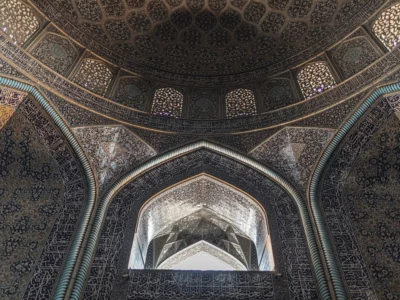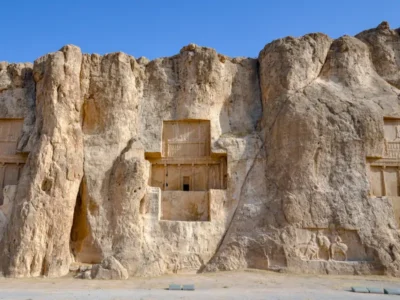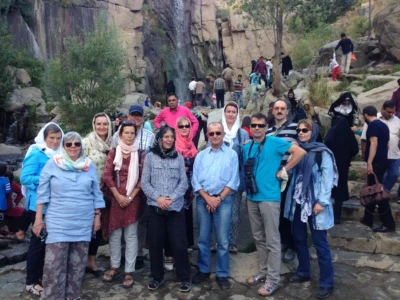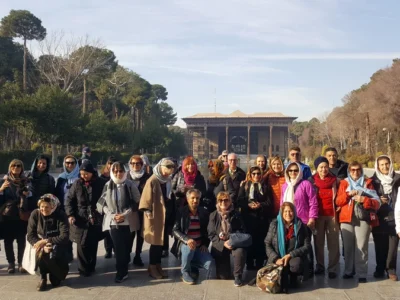KASHAN
Kashan is a historic city nestled in the heart of Iran's central desert region, approximately 240 kilometers south of Tehran. Situated in the Isfahan Province, Kashan is strategically located along the ancient Silk Road trade route, making it an important center of commerce, culture, and civilization for centuries.
Kashan is positioned on the edge of the Dasht-e Kavir, or Great Salt Desert, which stretches across much of central Iran. Its geographical coordinates are approximately 33.9831° N latitude and 51.4364° E longitude. The city is surrounded by desert landscapes, rocky mountains, and oasis-like valleys, creating a unique and captivating environment.
The nearby Karkas Mountains provide a stunning backdrop to the city, offering opportunities for outdoor activities such as hiking, mountain climbing, and nature exploration. Kashan's location at the crossroads of ancient trade routes has shaped its history, culture, and architectural heritage, making it a fascinating destination for travelers and historians alike.
Kashan is known for its picturesque landscapes, palm groves, orchards, and rose gardens dotting the desert terrain. The city's most distinctive feature is its historic underground water channels, known as qanats, which have been used for centuries to supply water to the town and surrounding areas. These qanats are a testament to ancient Persian civilizations' ingenuity and engineering prowess.
The Fin Garden, or Bagh-e Fin, is one of Kashan's most famous attractions. It is renowned for its lush greenery, beautiful fountains, and traditional Persian architecture. The garden dates back to the Safavid era and is a UNESCO World Heritage Site, attracting visitors worldwide with its serene beauty and historical significance.
Kashan has a rich and storied history that dates back thousands of years. It has been inhabited since ancient times, with evidence of human settlement dating back to the Neolithic period. Over the centuries, Kashan has been ruled by various dynasties, including the Achaemenids, the Parthians, and the Safavids, each leaving their mark on the city's culture and architecture.
One of Kashan's most famous historical figures is Amir Kabir, a prominent statesman and reformer who served as the chief minister to Naser al-Din Shah Qajar in the 19th century. The Fin Garden was his residence during his tenure, and a mausoleum commemorates his legacy within the garden grounds.
The population of Kashan has grown steadily over the years, driven by factors such as urbanization, economic development, and migration from rural areas. According to the latest estimates, the population of Kashan is approximately 400,000 people, making it a mid-sized city in Iran.
Kashan is known for its diverse population, comprising various ethnicities, including Persians, Azeris, and Lurs. The city's residents are known for their hospitality, warmth, and strong sense of community, creating a welcoming atmosphere for visitors and newcomers alike.
Kashan serves as an economic hub for the region, with a diverse economy driven by agriculture, tourism, handicrafts, and manufacturing sectors. The city is known for its production of rosewater, carpets, ceramics, and textiles, which are sold in local markets and exported to markets both domestically and internationally.
Tourism is also a significant contributor to Kashan's economy, with visitors flocking to the city to explore its historic landmarks, traditional bazaars, and cultural attractions. The city's unique blend of ancient and modern architecture, rich history, and vibrant culture make it a popular destination for travelers seeking an authentic Persian experience.
Despite its many strengths, Kashan faces several challenges, including water scarcity, environmental degradation, and urban sprawl. The city's reliance on underground water sources has put pressure on its aquifers, leading to depletion and contamination of its water supply.
However, Kashan also presents numerous opportunities for growth and development, including its strategic location, rich cultural heritage, and untapped tourism potential. By investing in sustainable development initiatives, infrastructure improvements, and conservation efforts, Kashan can overcome its challenges and emerge as a model of sustainable urban living in Iran.
In conclusion, Kashan is a historic and vibrant city located in the heart of Iran's central desert region. Its strategic location, rich cultural heritage, and dynamic population make it a unique and captivating destination for travelers and historians alike. With careful planning and investment, Kashan has the potential to become a thriving center of commerce, culture, and innovation for generations to come.
| Languages spoken | Persian/ Kashi dialect |
|---|---|
| Currency used | Iranian Rials |
| Country name | Iran |
Culture and history
Kashan is a city steeped in rich culture and history, with a legacy that spans thousands of years. From its ancient origins as a center of civilization to its role as a hub of trade and craftsmanship along the Silk Road, Kashan's cultural heritage is a testament to the creativity, ingenuity, and resilience of its people.
**Ancient Civilization**:
Kashan's history can be traced back to ancient times, with evidence of human settlement dating back to the Neolithic period. The city's strategic location along the Silk Road made it an important center of trade and commerce, connecting Persia with the civilizations of Mesopotamia, Central Asia, and China.
One of Kashan's most significant archaeological sites is the Sialk Ancient Mound, which dates back over 7,000 years. This site contains the remains of ancient settlements, including mud-brick structures, pottery shards, and artifacts that offer insights into the prehistoric cultures that once inhabited the region.
**Islamic Golden Age**:
During the Islamic Golden Age, Kashan flourished as a center of learning, art, and culture. The city became known for its skilled artisans, who produced exquisite textiles, ceramics, metalwork, and glassware highly prized throughout the Islamic world.
Kashan's architectural heritage flourished during this period, with the construction of magnificent mosques, palaces, and caravanserais. The city's historic bazaars bustled with activity, offering a vibrant marketplace for traders, merchants, and artisans across the region.
**Qajar Era**:
In the 19th century, Kashan reached new heights of prosperity under the Qajar dynasty. The city became a favored residence for wealthy merchants and aristocrats, who built opulent mansions and gardens that reflected their status and wealth.
Many of Kashan's historic houses, or "khanehs," date back to this period and showcase the finest examples of traditional Persian architecture. These houses feature elaborate stucco decorations, colorful frescoes, and intricately carved wooden doors and windows, offering a glimpse into the luxurious lifestyle of the Persian elite.
**Modern Era**:
In the modern era, Kashan continues to be a vibrant center of culture, commerce, and craftsmanship. The city's traditional industries, such as rosewater production, carpet weaving, and ceramics, thrive alongside modern technological developments, education, and tourism.
Kashan's cultural heritage is celebrated through various festivals, events, and cultural initiatives that showcase the city's artistic traditions and historical legacy. Visitors can explore its historic landmarks, museums, and traditional bazaars and participate in cultural activities such as music, dance, and theater.
In conclusion, Kashan's culture and history are deeply intertwined, shaping the city's identity and character over the centuries. From its ancient roots to its modern-day achievements, Kashan remains a testament to Iran's rich cultural heritage and a source of inspiration for future generations.
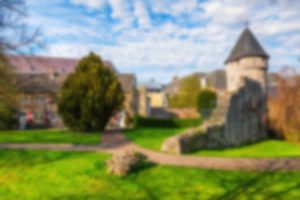
Tourist attractions
Kashan and its suburbs boast a variety of attractive attractions that reflect the city's rich history, culture, and natural beauty. Here are some of the most notable attractions:
1. **Fin Garden (Bagh-e Fin)**: Located in the heart of Kashan, Fin Garden is a UNESCO World Heritage Site and one of Iran's oldest surviving Persian gardens. It features lush greenery, flowing water channels, beautiful fountains, and traditional Persian architecture. The garden is particularly famous for its historic qanat system, which provides water to the site through underground channels.
2. **Tabatabaei House**: This historic mansion is an architectural masterpiece dating back to the 19th century. It showcases traditional Persian residential architecture, with intricate tilework, stained glass windows, and elegant courtyards. Visitors can explore the intricately decorated rooms and learn about the lifestyle of wealthy merchants during the Qajar era.
3. **Borujerdi House**: Another stunning example of traditional Persian architecture, Borujerdi House is renowned for its exquisite design and craftsmanship. Built in the 19th century, the mansion features elaborate stucco decorations, colorful frescoes, and a central courtyard with a reflecting pool. It offers insight into the opulent lifestyle of the Persian elite during the Qajar period.
4. **Agha Bozorg Mosque**: This historic mosque is one of Kashan's most important religious sites and architectural landmarks. Built in the 18th century, it boasts a magnificent portal adorned with intricate tilework and calligraphy. The mosque's interior features a spacious prayer hall, elegant iwans (arched halls), and a tranquil courtyard surrounded by arcades.
5. **Sialk Ancient Mound**: Located on the outskirts of Kashan, the Sialk Ancient Mound is one of the oldest archaeological sites in Iran, dating back over 7,000 years. It features the remains of ancient settlements, including mud-brick structures, pottery shards, and artifacts from the Neolithic and Chalcolithic periods. The site offers insights into the prehistoric cultures that once inhabited the region.
6. **Nushabad Underground City**: Situated near Kashan, Nushabad is home to an ancient underground city believed to date back to the Sassanian period (3rd to 7th centuries CE). The city consists of a network of tunnels, chambers, and rooms carved into the rock, which served as a refuge during times of war and invasion. Visitors can explore the underground passages and learn about the city's history and inhabitants.
7. **Maranjab Desert**: Located southwest of Kashan, the Maranjab Desert is a vast expanse of sand dunes, salt flats, and desert landscapes. It offers opportunities for desert camping, camel riding, and sandboarding, as well as breathtaking views of the sunset and night sky. The desert is also home to the Maranjab Caravanserai, an ancient stopover for travelers along the Silk Road.
These are just a few of the many attractions that Kashan and its suburbs have to offer. Whether you're interested in history, architecture, or outdoor adventure, there's something for everyone to explore and enjoy in this fascinating region of Iran.
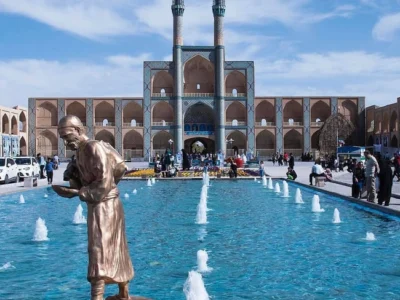
ANCIENT PERSIA
Tehran | Kashan| Naein | Yazd | IsfahanEmbark on a journey through time as you explore the prehistoric cities of Qom and Kashan, alongside the pre-Islamic marvels of Maybod, Yazd.

ANCIENT PERSIA
Tehran | Kashan| Naein | Yazd | IsfahanEmbark on a journey through time as you explore the cities of Qom and Kashan, alongside the pre-Islamic marvels of Maybod, Yazd.
Unfortunately no accommodations were found.

